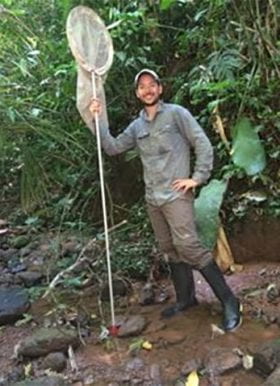
Brett Seymoure
Assistant Professor of Biological Sciences, University of Texas at El Paso
Now
Assistant Professor of Biological Sciences
University of Texas at El Paso
At LEC
Grossman Family Postdoctoral Fellow
Years: 2019-2022
Mentor(s): Anthony Dell (National Great Rivers Research and Education Center), Kasey Fowler-Finn (Saint Louis University), Amanda Koltz (WashU)
Research Focus: Study how light drives food webs and predator-prey interactions in spiders and insects. Brett investigated the effects of anthropogenic lighting at night on predation in arthropods by addressing three major research aims: (1) quantify effects of light conditions on arthropod behavior and predator-prey interactions; (2) measure visual abilities for respective species; and 3) integrate behavioral and physiological data to understand how light structures arthropod communities to make predictions of effects of light pollution on global arthropod biodiversity.
Natural and artificial light alter foraging behavior and physiology in wolf spiders project
Publications related to postdoctoral work
Broder D, Elias D, Morris M, Rosenthal G, Seymoure BM & Tinghitella R. (2021). Evolutionary novelty in communication between the sexes. Biology Letters. 16, 20200733. doi:10.1098/rsbl.2020.0733
Buxton R, Seymoure BM, White J, Angeloni L, Crooks K, Fristrup K, McKenna M. & Wittemyer G (2020). The relationship between anthropogenic light and noise in US National Parks. Landscape Ecology. 35, 1371-1384. doi:10.1007/s10980-020-01020-w
Crump M, Brown C, Lemoine N, Griffin-Nolan RJ, Angeloni L & Seymoure BM. (2021). Effects of low-level artificial light at night on Kentucky bluegrass and an introduced herbivore. Frontiers in Ecology and Evolution. 9, 732959. doi:10.3389/fevo.2021.732959
Ditmer M, Francis C, Barber J, Stoner D, Seymoure BM, Fristrup K & Carter N. (2021). Assessing the vulnerabilities of vertebrate species to light and noise pollution: Expert surveys illuminate the impacts on special species. Integrative and Comparative Biology. 61 (3), 1202-1215. doi:10.1093/icb/icab091
Dominoni DM, Halfwerk W, Baird E, Buxton RT, Fernandez-Juricic E, Fristrup KM, Markham KE, McKenna MF, Mennitt DJ, Perkin EK, Seymoure BM, Stoner D, Tennessen JB, Toth CA, Tyrell LP, Wilson A, Francis CD, Carter N & Barber JR. (2020). Why conservation biology needs sensory ecology. Nature Ecology and Evolution. 4 (4), 502-511. doi:10.1038/s41559-020-1135-4
Farhang S, Duffy D, Seymoure B. (2024). Variation in ground-dwelling arthropod communities across differently managed infiltration basins. The Canadian Entomologist. 156. doi:10.4039/tce.2024.8.
Jones B, Seymoure BM, Comi T & Loew E. (2020). Species and sex differences in eye morphology and visual sensitivity of nocturnal sweat bees (Megalopta spp., Hymenoptera: Halictidae). Biological Journal of the Linnean Society. 130 (3), 533-544. doi:10.1093/biolinnean/blaa064
Owens ACS, Cochard P, Durrant J, Farnworth B, Perkin EK & Seymoure BM. (2020). Light pollution is a driver of insect declines. Biological Conservation, 241, 108259. doi:10.1016/j.biocon.2019.108259
Seymoure BM, Dell AI, Holker F, & Kalinkat G. (2023). A framework for untangling the consequences of artificial light at night on species interactions. Philosophical Transactions of the Royal Society B. 378, 1892. doi:10.1098/rstb.2022.0356
Seymoure BM, Parrish T, Egan K, Furr M, Irwin D, Brown C, Crump M, White J, Crooks K, Angeloni L. (2023). Better red than dead: Plasticine moths are attacked less under HPS streetlights than LEDs. Basic and Applied Ecology. 74. doi:10.1016/j.baae.2023.11.008.
Wilson AA, Seymoure BM, Vosbigian R, Jaeger S, Payne H, Peria L, Milstead B & Francis CD. (2021). Direct and ambient light pollution alters recruitment for a diurnal plant-pollinator system. Integrative and Comparative Biology. 61 (3), 1122-1133. doi:10.1093/icb/icab010